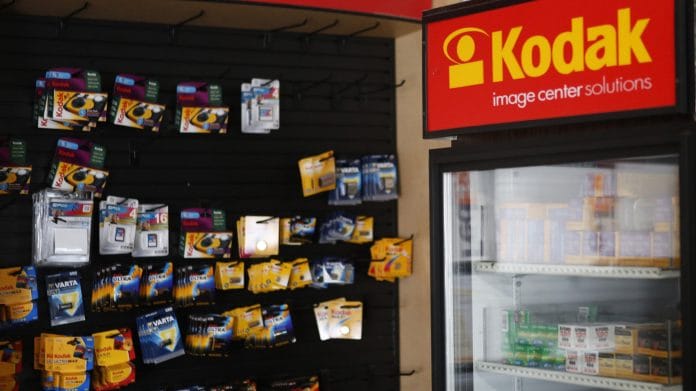Kodak, the once-iconic photo company that’s been languishing for years, surprised the world this week by announcing a pivot into the pharmaceuticals business with a $765 million head start from the U.S. government. Somehow, that was enough to send the stock soaring more than 1,000% and add more than $1 billion to the company’s market value. Really? Let’s discuss.
The Defense Production Act loan, announced Tuesday, is part of a Trump administration effort to bring the manufacture of drug ingredients back to U.S. shores to reduce dependence on other countries and ensure consistent supply. It’s a reasonable if challenging policy goal. The loan and new business line for Eastman Kodak Co. isn’t, however, anything close to a justification for its massive share-price gains — whatever day traders and Robinhood investors may say.
Kodak is attempting to enter a low-margin commodity market with no particular advantage outside of the current administration’s industrial policy. Unless the government money spigot keeps flowing, it’s hard to imagine the company ever living up to its lofty valuation.
Many of the world’s pharmaceutical ingredients come from China or India. This has become a concern in recent years because of quality-control issues and the recent specter of pandemic-related shortages. However, shifting the supply chain back to the U.S. isn’t the work of a few loans or a few years.
Re-shoring sounds appealing, but it’s challenging to successfully break into a commodity business from a standing start even with a boost from the government. And drug ingredients made in America by an inexperienced new entrant are likely to be more expensive than those available abroad in the absence of extreme and rare supply shocks.
Many large generic drugmakers that also make and use drug ingredients have been facing significant pricing pressure and slashing costs for years; few are likely to consistently buy American from a new source unless the government forces them. What’s more, higher ingredient costs would potentially filter through to higher drug prices, which is not exactly a popular idea.
Part of the enthusiasm may stem from the fact that Kodak reportedly aims to make drug ingredients used in the fight against Covid-19, including hydroxychloroquine, a medicine that President Donald Trump continues to tout as a possible treatment even though it has repeatedly failed to show a benefit in clinical trials.
To turn that into an investment thesis for Kodak, you have to believe that the medicine will finally succeed in a well-controlled trial, or that off-label prescriptions will be common. You have to think that the company, which has been out of the drug business for decades, will be able to retrofit factories and significantly ramp up production before vaccines or more effective treatments emerge. You have to believe that the company can compete on cost giants that have been in this business for decades or that Congress will pass a mandate handing it a market.
It’s unclear if anyone’s buying Kodak because they truly believe in the long-term potential of this project, as opposed to just day trading. Either way, good luck. – Bloomberg
Also read: Kodak is having a comeback moment as Oscars embrace film






